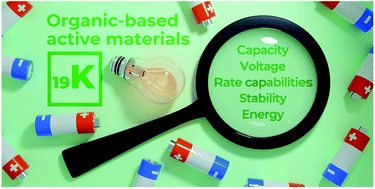Organic-based active electrode materials for potassium batteries: status and perspectives†
Abstract
If our demand for portable electronics and electric vehicles continues skyrocketing, lithium supplies, which are the basis for Li-ion batteries, might become scarce within several decades. Potassium-based batteries have recently attracted much attention as sustainable alternatives to Li-ion energy storage technologies. Potassium is a ubiquitous element, so its feedstocks are more than sufficient for extensive use in energy storage systems. It has been shown that potassium batteries might achieve high energy densities along with fast charge/discharge capabilities and superior cycling stability. Organic redox-active compounds have recently started to emerge as a promising class of materials for K-based batteries. They can be friendlier to the environment compared to inorganic alternatives and contain no expensive transition metals, which is crucial for sustainable development. For organic and metal–organic compounds, charge–discharge mechanisms are typically unspecific to the counter-ion, which makes the development of Li-ion battery alternatives easier. In this review, the recent progress of organic-based anode and cathode materials for potassium batteries is summarized. We define the main classes of redox-active compounds and their main challenges, analyze the performance of the materials compared to the best inorganic analogs, and reveal key strategies for improving energy density, rate capability and cycling stability.



 Please wait while we load your content...
Please wait while we load your content...